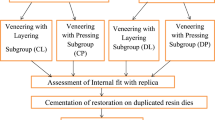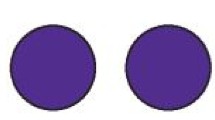Key Points
-
Within the limits of this investigation, it can be concluded that marginal accuracy of pressed all-ceramic FPD and the conventional MC techniques used are on a similar level.
-
In particular, almost all marginal gap values observed in this study were in the range of 50-100 μm, which is ideal for composite cement and seems to optimise performance.
-
The process of cementation reduces the marginal accuracy of FPD restorations irrespective of the FPD material.
-
After artificial aging marginal degradation of cement films was not significant using a resin-cement and dentine-bonding system for cementing the all-ceramic FPD. Therefore, the investigators judged resin-cements as the most suitable for cementing all-ceramic restorations.
Abstract
Purpose This study compares the marginal accuracy of posterior metal ceramic (MC), all-ceramic IPS Empress®2 and experimental pressed ceramic (EPC-VP 1989/4) three-unit fixed partial dentures (FPD), before and after luting and after thermo-mechanical fatigue in a dual-axis chewing simulator.
Materials and methods Caries-free human teeth (n=160) were used as abutments for the fabrication of eighty posterior three-unit FPD, divided into two test-groups, IPS Empress®2 and EPC, of 32 samples each and one control group of 16 samples metal ceramic FPD. All FPD were cemented with Variolink®II dual-curing resin cement. Half of the samples in each group were exposed to a dual-axis chewing simulator.
Results The geometric mean marginal gap values (μm, before cementation, after cementation and after thermo-mechanical fatigue) amounted to 53, 63 and 62 for the ceramic metal FPD, 57, 71 and 68 for the Empress®2 FPD and 55, 67 and 68 for the EPC FPD. In all groups a statistically significant increase in marginal gap width was observed after cementation. The effect of functional loading in the chewing simulator on marginal gap was not significant. Marginal gap was lowest in the control group but differences with all-ceramic materials were small in all evaluation stages.
Conclusion Within the limits of this investigation, it can be concluded that marginal gap values of these all-ceramic materials and conventional MC techniques are on a similar level. In particular, almost all marginal gap values observed in this study were within the limits of clinical acceptance.
Similar content being viewed by others
Log in or create a free account to read this content
Gain free access to this article, as well as selected content from this journal and more on nature.com
or
References
Burke FJ, Qualtrough AJ, Wilson NH . A retrospective evaluation of a series of dentin-bonded ceramic crowns. Quintessence Int 1998; 29: 103–106.
Weaver JD, Johnson GH, Bales DJ . Marginal adaptation of castable ceramic crowns. J Prosthet Dent 1991; 66: 747–753.
Sulaiman F, Chai J, Jameson LM, Wozniak WT . A comparison of the marginal fit of In-Ceram, IPS Empress, and Procera crowns. Int J Prosthodont 1997; 10: 478–484.
Beschnidt SM, Strub JR . Evaluation of the marginal accuracy of different all-ceramic crown systems after simulation in the artificial mouth. J Oral Rehabil 1999; 26: 582–593.
Boening KW, Wolf BH, Schmidt AE, Kastner K, Walter MH . Clinical fit of Procera AllCeram crowns. J Prosthet Dent 2000; 84: 419–424.
Gardner FM . Margins of complete crowns — literature review. J Prosthet Dent 1982; 48: 396–400.
Lang NP, Kiel RA, Anderhalden K . Clinical and microbiological effects of subgingival restorations with overhanging or clinically perfect margins. J Clin Periodontol 1983; 10: 563–578.
Knoernschild KL, Campbell SD . Periodontal tissue responses after insertion of artificial crowns and fixed partial dentures. J Prosthet Dent 2000; 84: 492–498.
Tuntiprawon M, Wilson PR . The effect of cement thickness on the fracture strength of all-ceramic crowns. Aust Dent J 1995; 40: 17–21.
Kappert HF, Altvater A . [Field study on the accuracy of fit and the marginal seal of In-Ceram crowns and bridges]. Dtsch Zahnarztl Z 1991; 46: 151–153.
May KB, Russell MM, Razzoog ME, Lang BR . Precision of fit: the Procera AllCeram crown. J Prosthet Dent 1998; 80: 394–404.
Sorensen JA, Kang SK, Torres TJ, Knode H . In-Ceram fixed partial dentures: three-year clinical trials. J Calif Dent Assoc 1998; 26: 207–214.
Chitmongkolsuk S, Heydecke G, Stappert CFJ, Strub JR . Fracture strength of all-ceramic lithium disilikate and porcelain-fused-to-metal bridges for molar replacement after dynamic loading. Eur J Prosthodont Restor Dent 2002; 10: 131–138.
Sorensen JA, Cruz M, Mito WT, Raffeiner O, Meredith HR, Foser HP : A clinical investigation on three-unit fixed partial dentures fabricated with lithium disilicate glass-ceramic. Pract Periodontics Aesthet Dent 1999;11: 95–106.
Rinke S, Behi F, Huls A . Fitting accuracy of all-ceramic posterior crowns produced with three different systems. J Dent Res 2001; 80: Special issue (IADR Abstracts) abstract no 0997 p 651.
Andersson M, Oden A . A new all-ceramic crown: A densely-sintered, high-purity aluminua coping with porcelain. Acta Odontol Scand 1993; 51: 59–64.
Ödman PA, Andersson B . Procera AllCeram crowns followed for 5-10.5 years. Int J Prostodont 2001; 14:
Tinschert J, Natt G, Mautsch W, Spiekermann H, Anusavice KJ . Marginal fit of alumina- and zirconia-based fixed partial dentures produced by CAD/CAM system. Oper Dent 2001; 26: 367–374.
Sparrius O, Grossman ES . Marginal leakage of composite resin restorations in combination with dentinal and enamel bonding agents. J Prosthet Dent 1989; 61: 678–684.
Kern M, Strub JR, Lu XY . Wear of composite resin veneering materials in a dual-axis chewing simulator. J Oral Rehabil 1999; 26: 372–378.
DeLong R, Douglas WH . An artificial oral environment for testing dental materials. IEEE Trans Biomed Eng 1991; 38: 339–345.
Sorensen JA . A standardized method for determination of crown margin fidelity. J Prosthet Dent 1990; 64: 18–24.
DeLong R, Sakaguchi RL, Douglas WH, Pintado MR . The wear of dental amalgam in an artificial mouth: a clinical correlation. Dent Mater 1985; 1: 238–242.
Sakaguchi RL, Douglas WH, DeLong R, Pintado MR . The wear of a posterior composite in an artificial mouth: a clinical correlation. Dent Mater 1986; 2: 235–240.
Bates JF, Stafford GD, Harrison A . Masticatory function - a review of the literature. III. Masticatory performance and efficiency. J Oral Rehabil 1976; 3: 57–67.
Kumagai H, Suzuki T, Hamada T, Sondang P, Fujitan M . Occlusal force distribution on the dental arch during various levels of clenching. J Oral Rehabil 1999; 26: 932–935.
Rinke S, Huls A, Jahn L . Marginal accuracy and fracture strength of conventional and copy-milled all-ceramic crowns. Int J Prosthodont 1995; 8: 303–310.
Groten M, Axmann D, Probster L, Weber H . Determination of the minimum number of marginal gap measurements required for practical in-vitro testing. J Prosthet Dent 2000; 83: 40–49.
Davis DR . Comparison of fit of two types of all-ceramic crowns. J Prosthet Dent 1988; 59: 12–16.
Pera P, Gilodi S, Bassi F, Carossa S . In vitro marginal adaptation of alumina porcelain ceramic crowns. J Prosthet Dent 1994; 72: 585–590.
Friedlander LD, Munoz CA, Goodacre CJ, Doyle MG, Moore BK . The effect of tooth preparation design on the breaking strength of Dicor crowns: Part 1. Int J Prosthodont 1990; 3: 159–168.
Pröbster L . Compressive strength of two modern all-ceramic crowns. Int J Prosthodont 1992; 5: 409–414.
Kern M, Schaller HG, Strub JR . Marginal fit of restorations before and after cementation in vivo. Int J Prosthodont 1993; 6: 585–591.
Bieniek KW, Marx R . The mechanical loading capacity of new all-ceramic crown and bridge materials. Schweiz Monatsschr Zahnmed 1994; 104: 284–289.
Ferrari M, Mason PN, Poli L, Di Dente M . Marginal adaptation of crowns: a scanning electron microscopic investigation. Int J Periodont Rest Dent 1994; 14: 273–279.
Steinbrenner H, Eickholz P, Staehle HJ . Zur Reproduzierbarkeit der qualitativen und quantitativen Randanalyse. Dtsch Zahnärztl Z 1995; 50: 920–923.
Molin MK, Karlsson SL, Kristiansen MS . Influence of film thickness on joint bend strength of a ceramic/resin composite joint. Dent Mater 1996; 12: 245–249.
Fransson B, Oilo G, Gjeitanger R . The fit of metal-ceramic crowns, a clinical study. Dent Mater 1985; 1: 197–199.
Karlsson S . The fit of Procera titanium crowns. An in vitro and clinical study. Acta Odontol Scand 1993; 51: 129–134.
Belser UC, MacEntee MI, Richter WA . Fit of three porcelain-fused-to-metal marginal designs in vivo: a scanning electron microscope study. J Prosthet Dent 1985; 5: 24–29.
Kawai K, Isenberg BP, Leinfelder KF . Effect of gap dimension on composite resin cement wear. Quintessence Int 1994; 25: 53–58.
Bayne SC, Taylor DF, Rekow ED, Wilder AD, Heymann HO . Confirmation of Leinfelder clinical wear standards. Dent Mater 1994; 10: 11–18.
Buchalla W, Attin T, Hellwig E . Brushing abrasion of luting cements under neutral and acidic conditions. Oper Dent 2000; 25: 482–487.
Yoshinari M, Derand T . Fracture strength of all-ceramic crowns. Int J Prosthodont 1994; 7: 329–338.
Hahn P, Schaller H, Hafner P, Hellwig E . Effect of different luting procedures on the seating of ceramic inlays. J Oral Rehabil 2000; 27: 1–8.
Alkumru HN, Wilson HJ, Bor S . The fit of all-ceramic crowns cemented with different luting agents. J Marmara University Dental Faculty 1992; 1: 198.
Oilo G, Evje D . Film thickness of dental luting cements. Dent Mater 1986; 2: 85–289.
Staninec M, Giles WS, Saiku JM, Hattori M . Caries penetration and cement thickness of three luting agents. Int J Prosthodont 1988; 1: 259–263.
Eppenberger J, Marinello CP, Scherle W, Schärer P . Composite as an attachment cement? Initial clinical experiences in crown and bridge prosthetics. Schweiz Monatsschr Zahnheilk 1987; 97: 1237–1250.
Krejci I, Mueller E, Lutz F . Effects of thermocycling and occlusal force on adhesive composite crowns. J Dent Res 1994; 73: 1228–1232.
Acknowledgements
The authors are very grateful to Prof. Dr. H. F. Kappert, PD Dr. R. Kohal and M. Bächle. Technical support by Vivadent-Ivoclar AG, Schaan, FL - H. P. Foser.
Author information
Authors and Affiliations
Corresponding author
Additional information
Refereed paper
Rights and permissions
About this article
Cite this article
Stappert, C., Dai, M., Chitmongkolsuk, S. et al. Marginal adaptation of three-unit fixed partial dentures constructed from pressed ceramic systems. Br Dent J 196, 766–770 (2004). https://doi.org/10.1038/sj.bdj.4811390
Received:
Accepted:
Published:
Issue date:
DOI: https://doi.org/10.1038/sj.bdj.4811390
This article is cited by
-
The effect of pre-ceramic soldering on marginal and internal fit of 4-unit zirconia frameworks and monolithic zirconia fixed dental prostheses
Odontology (2024)
-
Marginal adaptation of lithium disilicate ceramic crowns cemented with three different resin cements
Clinical Oral Investigations (2019)
-
Pressed ceramic in fixed partial dentures construction
British Dental Journal (2004)



